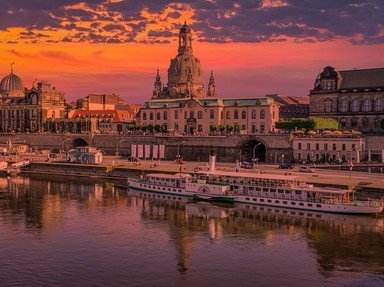Quiz Answer Key and Fun Facts
1. Dresden is the capital of which easternmost state of the Federal Republic of Germany?
2. Dresden sits on which of the following rivers?
3. Which of the following most nearly approximates the meaning of the name Dresden?
4. What event in 2002 caused one television news station to nickname Dresden "Germany's Venice"?
5. Which Royal Saxon Court Conductor was an active participant (if not ringleader) in the unsuccessful May Uprising in Dresden in 1849?
6. The Frauenkirche (Church of Our Lady) dominates the Dresden skyline. Originally Eastern Orthodox, it was rebuilt in 1727 by which denomination?
7. Which of these neat, offbeat German museums is in Dresden?
8. Between 1959 and 2009 Dresden was twinned with a total of 13 other cities from around the world, but which of these cities - that also suffered severe damage in WW2 bombing raids - was the first of them?
9. Thanks to its incredible architectural works and wonderful investment in the arts, Dresden has been labelled the cultural heart of Germany and likened to which Italian city?
10. The Semperoper is of enormous cultural importance to Dresden. What is it?
11. Dresden markets itself as one of Europe's greenest cities, boasting that it retains what percentage of area devoted to woods and green space?
12. Which of these famed attractions in Dresden's Kunsthofpassage (Art Courtyard Passage) is best enjoyed during inclement weather?
13. Dresden lost a UNESCO World Heritage listing.
14. The antipode of a place on earth is the point on the Earth's surface diametrically opposite to it. What is the closest town to Dresden's antipode?
15. What is the Green Vault, located in Dresden?
Source: Author
JCSon
This quiz was reviewed by FunTrivia editor
agony before going online.
Any errors found in FunTrivia content are routinely corrected through our feedback system.
